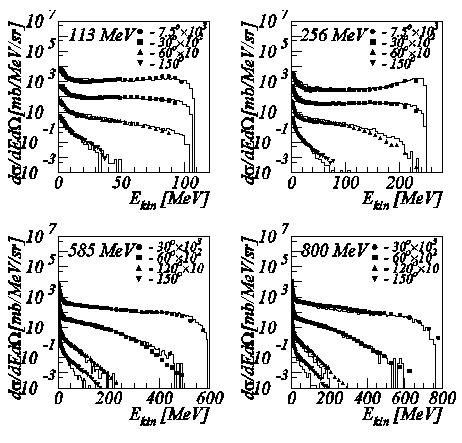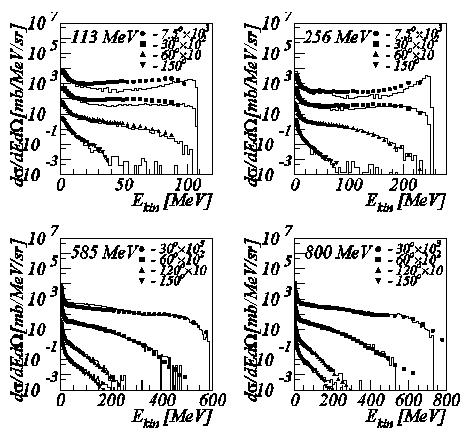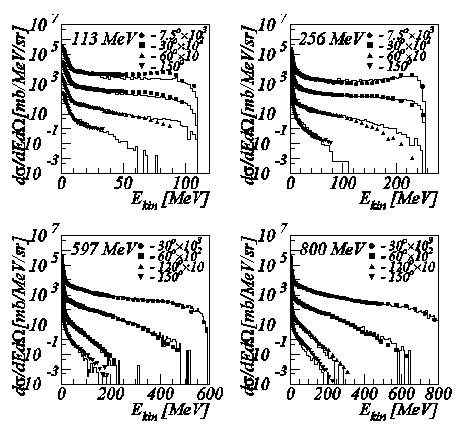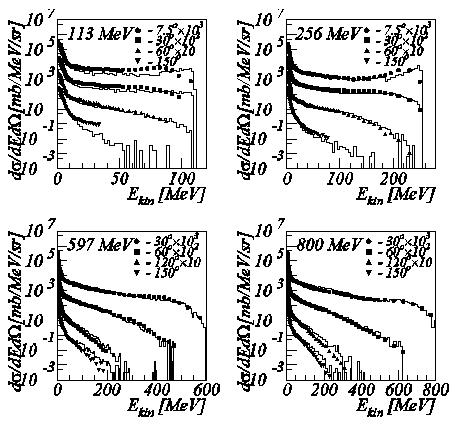Proton beams between 113 and 800 MeV are incident upon several targets. The double-differential neutron cross sections are measured vs. angle and kinetic energy. - References:
- Aluminum and Lead 113 MeV: M.M. Meier et al., Nucl. Sci. Eng. 102, 310 (1989).
- Aluminum and Lead 256 and 800 MeV: S. Stamer et al., Phys. Rev. C 47, 1647 (1993).
- Aluminum and Lead 597 MeV: W.B. Amian et al., Nucl. Sci. Eng. 110, 289 (1992).
Simulation Conditions - Geant4 version: 8.1
- Models: Binary, Bertini cascades
Comments - For 113 and 256 MeV plots:
- top curve: 7.5 degree data X 1000
- next-to-top curve: 30 degrees X 100
- next-to-bottom curve: 60 degrees X 10
- bottom curve: 150 degrees X 1
- For 585 and 800 MeV plots:
- top curve: 30 degree data X 1000
- next-to-top curve: 60 degree data X 100
- next-to-bottom curve: 120 degree data X 10
- bottom curve: 150 degrees X 1
- Data is the same for each group of four plots
- Aluminum data:
- Binary cascade agrees well with 7.5 and 30 degree data at all energies, but increasingly with energy under-estimates the data at 120 and 150 degrees. Deviations are by factors of 2 at 256 MeV, and factors of 5 and 10 at 585 and 800 MeV
- Bertini cascade shows poor agreement at 7.5 and 30 degrees for 113 and 256 MeV, deviating by factors of 2 to 4. At 60 and 150 degrees, agreement is excellent at these energies. At 585 and 800 MeV agreement is generally good at all angles, except at 800 MeV, 30 and 60 degrees, where the model cuts off prematurely in energy.
- Lead data:
- Binary cascade: at 113 MeV the model under-estimates the data by up to a factor of 4 at 7.5 degrees. Agreement improves with increasing angle. At 256 MeV agreement is good at 7.5 and 30 degrees, but the model over-estimates by up to a factor of 10 at 60 degrees. At 597 and 800 MeV there is excellent agreement at 30 and 60 degrees, but the model under-estimates by factors of 2 at 120 and 150 degrees.
- Bertini cascade: at 113 MeV the model shows excellent agreement at 60 degrees, but significantly under-estimates the data at 7.5 degrees (50% low), 30 degrees (30% low) and 150 degrees (90% low). At 256 MeV agreement is good at 7.5, 30 and 60 with the model under-estimating by 30-50% at 150 degrees. At 597 and 800 MeV agreement is good for 30 and 60 degrees, while at 120 and 150 degrees, the model over-estimates data by factors of 2 to 4.
Summary - For Al the binary cascade reproduces small-angle data (less than 60 degrees) better than Bertini cascade. For large-angle data, Bertini does better.
- For Pb, the binary cascade is as good or better than the Bertini cascade at all angles in this energy range.
Plots     | 


